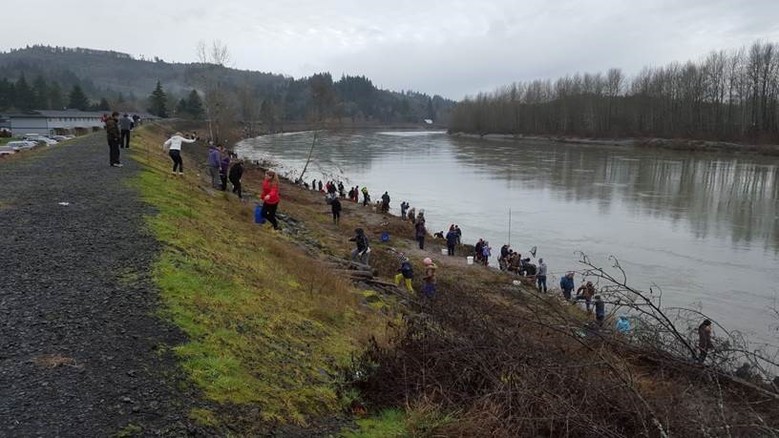Columbia River smelt return could see a slight upswing and may lead to a brief Cowlitz sport dip-net fishery for first time since 2017 1

Sport dip-netters line the Cowlitz River for smelt in 2017, the last time a recreational opportunity occurred. Photo courtesy of the WDFW.
If you can’t smell the flowers or in this case the eulachon – better known to many as smelt – then it’s likely that sniffing them out in the Columbia River mainstem or two lower-river tributaries will depend on in-season factors, according to a recently released joint Washington and Oregon fishery managers stock assessment report.
“The environmental indicators used to predict eulachon abundance are mixed (better for some age-classes than others) for the 2020 smelt return,” said Laura Heironimus, a Washington Department of Fish and Wildlife (WDFW) biologist.
The report indicates the 2020 smelt return is a low to moderate run size and expected to be similar to the 2019 return, which was an estimated 4.2-million pounds.
That 2019 smelt return estimate was the highest since 2016 and 66 percent of the 2011 to 2018 average. It also paints a much brighter picture than the 370,000 pounds in 2018 and 1.6-million pounds in 2017.
“Due to the protected status of the species, the states are taking a precautionary approach to management,” Heironimus said. “(We) will be in a better position to evaluate the feasibility of supporting a recreational fishery as more data become available.”
Washington and Oregon fishery managers along with the National Marine Fisheries Service agreed to have a Columbia River mainstem test-level gill-net commercial fishery in 2020 to gain biological and data on the return. They will occur Mondays and Thursdays (7 a.m. to 5 p.m.) from Feb. 3-27.
If the abundance looks strong enough then there could be a possibility of a small harvest opportunities in the Cowlitz or Sandy rivers.
During 2014-2017, limited sport smelt fisheries occurred in the Cowlitz and Sandy rivers. In the Cowlitz it was limited to one to five days annually (five to six hours per day) and the Sandy was only open in 2014 and 2015 (two to four days annually and six hours per day). During those times sport dip-netters harvest averaged 159,060 pounds with a low of 540 pounds to a high of 290,770 pounds.
There were commercial fisheries from 2014 to 2018 consisted of eight fishing periods over four weeks on the Columbia River mainstem.
Sport dip-netting for smelt was a huge draw from the 1980s to the early 2000s when thousands of people dressed in waders and dip-nets would line the Cowlitz River shoreline.
Smelt returns have steadily declined to the point where they were listed on the Endangered Species Act in the spring of 2010. Commercial and recreational fisheries were subsequently closed in 2011-2013.
There was one day of sport dip-netting in 2017 when 1.6-million pounds returned; and one day in 2016 when 5.1-million pounds returned along with opportunities both years on the Sandy River in Oregon.
There were also fishing seasons – five days total in 2014 and two days in 2015 –plus opportunities on the Sandy River.
Smelt abundance increased steadily from 2011 to 2014 when it peaked at 16.6-million pounds in 2014.
Ocean environmental conditions were favorable for marine survival during 2012-2013 but then deteriorated dramatically although improvement was seen the past few years.
Here’s a breakdown of Columbia River total run sizes and harvest catches:
2019: 4,205,000 pounds, with 23,660 pounds caught in tribal commercial fisheries, and no catch for sport and non-tribal commercial fisheries.
2018: 370,000 pounds, with 110 pounds caught in non-tribal commercial fishery, and no catch for sport and tribal fisheries.
2017: 1,600,00 pounds, with 5,090 pounds caught in non-tribal commercial fishery, 540 pounds in sport fishery and 1,900 pounds in the tribal fishery.
2016: 5,100,00 pounds, with 4,820 pounds caught in non-tribal commercial fishery, 141,050 pounds in sport fishery and 8,330 pounds in the tribal fishery.
2015: 11,400,000 pounds, 16,550 pounds caught in non-tribal commercial fishery, 290,770 pounds in sport fishery and 10,400 pounds in the tribal fishery.
2014: 6,600,00 pounds, with 18,560 pounds caught in non-tribal commercial fishery, 203,880 pounds in sport fishery and 6,970 pounds in the tribal fishery.
2013: 9,600,000 pounds, with none caught in non-tribal commercial fishery, no catch in sport fishery and 7,470 pounds in the tribal fishery.
2012: 3,200,00 pounds, with none caught in non-tribal commercial fishery, no catch in sport fishery and no data available in the tribal fishery.
2011: 3,300,00 pounds, with none caught in non-tribal commercial fishery, no catch in sport fishery and no data available in the tribal fishery.


I live in The Longview/Kelso area and grew up dipping smelt. Some time ago I was in the Longview historical center and came across an article from the then Castle Rock news paper dating back to the turn of the last century. The article stated that not a single smelt had returned to the Cowlitz River in nearly 20 years, which makes me believe that they are not endangered but cyclical.